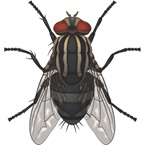Species category: Flying pest
Scientific name: Calliphoridae
Family: Sarcophagidae
Description
There are 2 different species:
1) Chrysomya megacephala (Oriental Latrine Fly)
2) Lucilia cuprina (Australian Sheep Blowfly)
Typically blue, black or green, these insects have a metallic sheen and are easily identified. They are slightly larger than common houseflies but they have some similarities. Blowflies are locally known as ‘langau´ in Malay, or ‘Bluebottle’ and ‘Greenbottle’ flies. They are common flies found in dumping areas.
Behaviour
The term 'blow' refers to the tendency of this insect group to lay their eggs (oviposit) or lay live larvae (larviposit) on human food, dead animals or animal waste. They usually arrive quickly after an animal dies especially if breeding occurs.
Blowflies feed on a variety of foods but the larvae more commonly live on decomposing organic matter. They play an important role in the breakdown of animal tissue. Maggots found in exposed meat or animal carcasses are almost always from blowfly species. Presence of Sarcophagid adults indicates a dead animal is nearby.
Region
Blowflies are present in many temperate regions around the world, and are widespread in Singapore.
Habitat
Blowflies can travel for miles in search of the perfect egg-laying site and will stay close to that site, laying multiple batches of eggs. They are often on the scene of an animal death within a very short space of time.
Risks
Due to their lifestyle and preference for decaying organic matter, blowflies are vectors of a wide variety of pathogens of harmful diseases. They transmit diseases and bacterial infections to both humans and animals. Certain species are particularly harmful to sheep if they access an open wound. They eat the decaying flesh of the wound and inflame it, in some cases causing blood poisoning.

